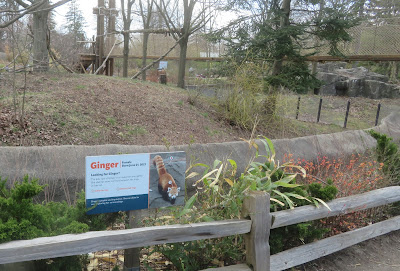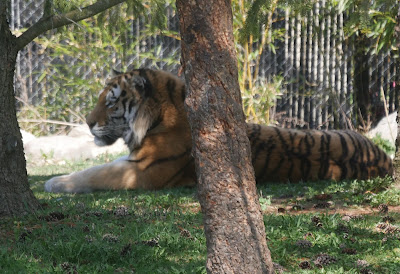Speaking of fads, just a little walk away were four Bactrian Camels (E), and off behind them in a little paddock were a few Mediterranean Miniature Donkeys--too far away to actually see much of. Across from the Camels was a lovely fountain. The Horace H. Rackham Memorial Fountain (F) commissioned by his widow, Mary, to commemorate the fact that among very many other philanthropic and civic associations of her late husband was the fact that he was the first president of the Detroit Zoological Commission. Because she had more money than God, she sought out a sculptor of some renown and landed on the Italian artist, Corrado Parducci. By the time the fountain was commissioned in 1939, Parducci was well established in Detroit having immigrated from a small village in Italy 15 years earlier. Parducci presented his preliminary design and the widow Rackham said, "Bears". She wanted bears. Parducci protested, but was no match for Mary's will or pocket book. In an oral history interview in 1975 with a historian from the Smithsonian American Art Institution, Parducci said of the fountain, "I didn't like that. I made it against my will...Mrs. Rackham was sold on that, bears..." As Paul Harvey would have said, "And now you know the rest of the story!"
Turning back to the path and walking on another couple of minutes we followed a sign and found the Holtzman Wildlife Foundation Red Panda Forest Habitat (G). The former habitat was expanded with the financial support of the Holtzman Wildlife Foundation in 2017-2018. The Detroit Zoo has the largest habitat for this species, I've ever seen anywhere--credit where credit is due. The zoo is home to a breading pair: Fred and Ginger. I do not know if they can dance. On this temperate sunny Tuesday morning, Ginger was out for a brief exploration of treats placed out overnight by the keepers. Our timing was propitious.
On the walk I saw two more volunteers raking leaves from a little garden of budding irises. Both were in a place away from guests and focused on their work.
Just a little further was a very large Devereaux Tiger Forest Habitat (H). Initially, try as we might we spotted nothing. On the verge of calling it on account of "no tigre en casa," I spied a women looking intently toward the back of the habitat among a little grove of droopy white spruce, and there was a tiger, pancaked flat to the ground sleeping in the shadows. According to the signage, the Detroit Zoo is home to two Amur Tigers; Nikolai and Ameliya. Nikolai was born at the Columbus Zoo with a twin brother, Aleksei, in 2016. In 2017, the pair was moved to Detroit to be with there elderly female, Kisa, who was born at the Detroit Zoo in 2003. This habitat had a $3,500,000.00 make-over between 2018-2019. Aleksei was relocated via an AZA SSP recommendation and Kisa passed in June of 2022 at the age of 18! A year prior, Ameliya arrived at the zoo in December of 2021 and debuted with the public in January of 2022. Ameliya was born at the Potter Park Zoo in Lansing, Michigan in 2011 and is paired with Nikolai as a SSP (Species Survival Program) breeding recommendation.
The placard maps indicated and the website implied that Long-tailed Macaques resided in a habitat carved out the far side of the Tiger Holding facility; however, some up-dates are in order. The zoo is now home to a pair of Allen's Swamp Monkeys. Beautiful monkeys that call central Africa home, unlike the Macaques who are native to Asia like the rest of the animals in the "Asian Forest" section. But, hey, I get it, my beloved zoo has an Amur Le0pard in the middle of our African Journey! It happens.






















No comments:
Post a Comment